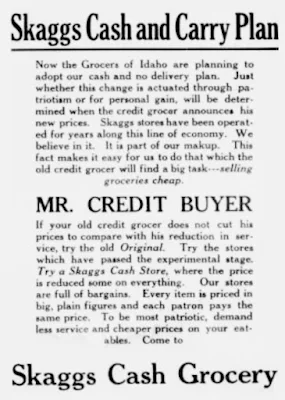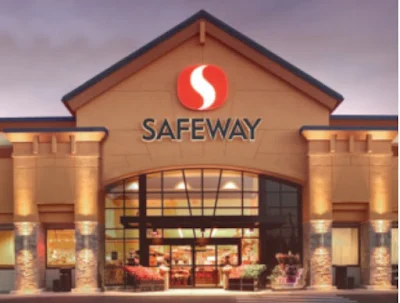America's mighty Safeway chain had humble beginnings in two locales. The first was American Falls, Idaho where, in April 1915, Samuel M. Skaggs opened the Skaggs Cash Grocery. The original store encompassed a meager 576 square feet. Samuel Skaggs was an early proponent of the self-service store format introduced by Piggly Wiggly.
Photo from Safeway Stores, Incorporated Annual Report 1959
The grocery was strictly a cash-only enterprise, with no credit extended to customers. This concept is explained in the newspaper ad above, which dates to January 1918. Samuel Skaggs sold the store to his son Marion B. Skaggs, in 1916. With the help of his brothers, M.B. Skaggs expanded the business. By 1920, 191 Skaggs Cash Grocery stores were operating in Idaho and Montana.
Advert from Skaggs Cash Grocery
Oscar P. Skaggs, one of M.B. Skaggs' brothers, split from the Skaggs Cash Grocery company and established a chain of Skaggs Cash Stores in Idaho, Nevada and California. Both enterprises merged in 1919, forming Skaggs United Stores. The new company's ethos is explained in the newspaper ad (on top) from February 1919.
Advert from Skaggs United Stores
Graphic from Skaggs United Stores
A holding company was established in 1926. Safeway Stores, Incorporated {Maryland} held stock in the three divisions. Safeway had 1,079 stores and was the largest supermarket chain west of the Mississippi. During 1928, stores were bought in Phoenix, El Paso, Maryland, Virginia and the District of Columbia. In 1929, chains in Tulsa, Salt Lake City and Vancouver {Canada} were obtained. The total number of stores was 4,026 (3,876 in the USA and 150 in Canada), which would be the peak number ever operated.
The second locale of Safeway's origination was Los Angeles. In April 1912, Samuel Seelig opened a grocery store at the intersection of West Pico Boulevard and South Figeroa Street.
Graphic from the Sam Seelig Company
By 1917, there were fifteen Sam Seelig stores. The chain grew rapidly, with 100 stores in operation by 1922. Eventually, the company was deeply in debt to its main wholesaler, which was owned by W.R.H. Weldon. A stock-for-debt swap was made, with Weldon assuming control. Seelig stayed on as manager, but retired in January 1925. At this time, there were 265 stores.
Advert from the Sam Seelig Company
In 1925, a contest was held to rename the company, with a "Safeway" submission being the winner. In 1926, Charles Merrill (of Merrill, Lynch & Company) acquired controlling interest in Safeway Stores and orchestrated a merger with Skaggs United Stores. The deal was finalized on July 1st of the same year.
Graphic from the Sam Seelig Company
Three incorporated divisions were formed. Skaggs-Safeway Stores {Oakland} would operate in northern and central California. Safeway Stores {Los Angeles} was charged with stores in southern California. Safeway Stores {Reno} ran units in Colorado, Idaho, Montana, Nebraska, Nevada, Oregon, Utah and Wyoming.
Graphic from Skaggs-Safeway Stores, Incorporated
Graphic from Safeway Stores, Incorporated
By 1930, these numbers had fallen slightly, with 2,691 (2,538 in the USA and 153 in Canada). The largest acquisition involved Los Angeles' MacMarr chain, which was bought in 1931. At this time, the corporate headquarters was in Reno, Nevada. It was moved to Oakland, California in 1942. In 1946, there were 2,413 Safeway units in twenty-three states, the District of Columbia and five Canadian provinces.
Photo from Safeway Stores, Incorporated Annual Report 1946
Here, we see a mid-1940s collection of Safeway house brand products. These include Royal Satin Shortening, Nu Made Mayonnaise, Kitchen Craft Flour, Busy Baker Crackers, Edwards Coffee and Su-Purb Granulated Soap.
Photo from Safeway Stores, Incorporated Annual Report 1945
A new logo was introduced in 1952. Safeway Stores was operating a total of 1,954 units in Arkansas, Arizona, California, Colorado, Idaho, Iowa, Kansas, Maryland, Missouri, Mississippi, Montana, Nebraska, Nevada, New Jersey, New Mexico, New York, Oklahoma, Oregon, South Dakota, Texas, Utah, Virginia, Washington State and the District of Columbia. The 138 Canadian stores were in Alberta, British Columbia, Manitoba, Ontario and Saskatchewan.
Graphic from Safeway Stores, Incorporated
During the mid-century years, existing stores were being remodeled and-or enlarged, with self-service meat departments, fluorescent lighting, refrigerated produce equipment and air-conditioning installed. Newly-built stores of the era encompassed between 18,500 and 24,400 square feet.
Photo from Safeway Stores, Incorporated Annual Report 1955
A panoramic view of a 1950s Safeway store shows spacious aisles stocked with just about everything imaginable. Walls are painted with subtle, pastel colors that highlight the merchandise and provide eye appeal.
Photo from Safeway Stores, Incorporated Annual Report 1953
This ultra-modern, arched roof Safeway was built in San Francisco and welcomed first shoppers in 1959. Located along the city's Marina Boulevard, it was the first in a series of "Marina" stores.
Photo from Safeway Stores, Incorporated Annual Report 1968
A vintage interior view of the Marina store. In 1960, the company was operating 2,000 units in twenty-eight states (stores in Alaska and Louisiana having recently opened). International branches followed in the United Kingdom (1962-1987), Australia (1963-1985), West Germany (1964-1985) and Mexico (1981-). Hawaiian stores opened in 1963 (this market having been abandoned in 1934).
Photo from Safeway Stores, Incorporated Annual Report 1959
An updated logo was introduced in 1982, when the company maintained 1,769 stores in twenty-seven states and the District of Columbia. There were 685 additional stores in Canada, the UK, Australia, West Germany and Mexico. The chain rejected a hostile takeover in July 1986 and was sold to New York City's Kohlberg, Kravis, Roberts & Company. Safeway was taken private and soon became immersed in debt. Various divisions were sold or downsized.
Graphic from Safeway Stores, Incorporated
The corporate headquarters was moved from Oakland to Pleasanton, California in 1996. By the late '90s, Safeway was -once again- in an expansion mode. Acquisitions included Vons {California}, Dominick's {Illinois} and Randall's and Tom Thumb {Texas}. In the year 2000, Genuardi's {Pennsylvania} was also obtained. A new "Lifestyle" store format debuted in 2003, which -among other things- featured organic produce and "restaurant quality meat solutions."
Photo from "Safeway Fact Book" 2003
In the 2010s, unprofitable Genuardi's and Dominick's stores were sold, as was the entire Canadian division. A joint venture of Albertsons and Cerberus Capital Management acquired Safeway Stores, with the deal closing on January 30, 2015. As of mid-2023, there were 913 Safeway stores operating in Alaska, Arizona, California, Colorado, Delaware, Hawaii, Idaho, Maryland, Montana, Nebraska, Nevada, New Mexico, Oregon, South Dakota, Virginia, Washington State, the District of Columbia and Wyoming.
Graphic from https://www.safeway.com
SAFEWAY JUNIOR-ANCHORED SHOPPING MALLS:
*BLUE RIDGE CENTER, Kansas City and Independence, MO (1958)
*METCALF SOUTH CENTER, Overland Park, KS (1967)
*BUCKINGHAM SQUARE, Aurora, CO (1971)























